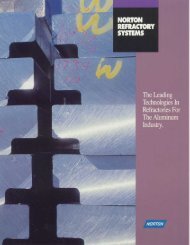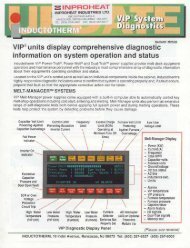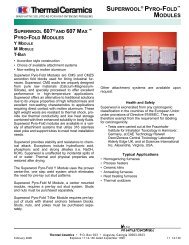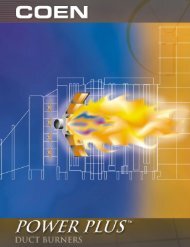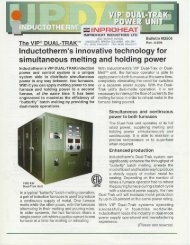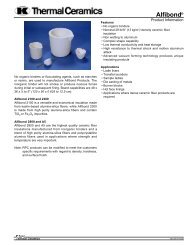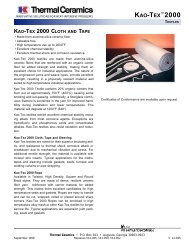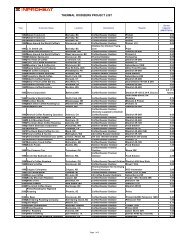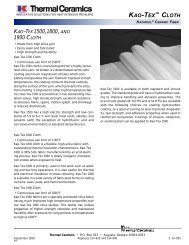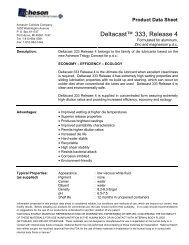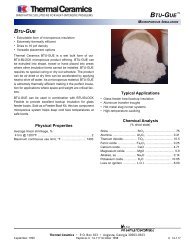Coen Development of a High Performance Versatile Low ... - Inproheat
Coen Development of a High Performance Versatile Low ... - Inproheat
Coen Development of a High Performance Versatile Low ... - Inproheat
Create successful ePaper yourself
Turn your PDF publications into a flip-book with our unique Google optimized e-Paper software.
The mixture <strong>of</strong> primary gas and air is very lean. This mixture gradually burners in the furnace asit mixes with combustion products <strong>of</strong> the core, hot furnace gases and secondary fuel. Thiscombustion process is mostly taking place at the lean limits <strong>of</strong> flammability, thus formation <strong>of</strong> bothprompt and thermal NOx are greatly reduced.The secondary fuel ignition point is also delayed as the furnace gases in the area around theburner has very low oxygen content. Gradual burning starts as the secondary fuel engagesoxygen from the combustion air both prior and after the combustion <strong>of</strong> primary gas.The core fuel is a small percentage <strong>of</strong> the overall fuel flow. It provides a reliable ignition sourcefor the primary and secondary fuel.An overall interleaving pattern <strong>of</strong> air and fuel distribution creates conditions for a sufficientlycompact overall flame and low carbon monoxide emissions with low excess air.As the mixing <strong>of</strong> primary gas and air takes place inside the burner, flash back can happen at lowloads. This problem was addressed during the early development stage by simply allowing flashback to occur. This typically happens with one or two slots <strong>of</strong> air and primary gas flow at theloads below 20%. At these reduced loads flash back is continuous, but does not cause anydamage to the burner. Each small flash back flame is surrounded by considerable amount <strong>of</strong>combustion air and is not in contact with the burner parts. The overall turn down <strong>of</strong> the burner is1.2 to 1.3 times <strong>of</strong> the turn down in the combustion air flow. Typically turn down <strong>of</strong> 8:1 to 10:1can be met with the basic QLN design without a significant increase in CO emissions. Forspecial applications requiring wider turn downs a special modified QLN burner was developedthat is capable <strong>of</strong> a turn down up to 2.5 times that <strong>of</strong> the turn down <strong>of</strong> the combustion air. Withthe adequate fuel controls this easily translates into the burner turn downs over 15:1. This higherturn down modification, however, shows slightly higher NOx.The above description is based on the observations <strong>of</strong> the flame patterns generated by burners<strong>of</strong> different sizes operating under different conditions. CFD modeling was only moderatelyused in the burner design, as accurate predictions <strong>of</strong> ignition points flame fronts, etc. are stillvery difficult and not reliable for this complex three dimensional problem even with modern CFDcodes like Fluent. Some useful results came from the mixing model between primary gas andair that helped in the optimization process. Most <strong>of</strong> the work, however, was done experimentally.The burner also shows good NOx performance when firing oil. This is attributed to the effect <strong>of</strong>enhanced recirculation <strong>of</strong> combustion products in the part <strong>of</strong> the furnace adjacent to the burnerand the effect <strong>of</strong> air staging. As the major portion <strong>of</strong> combustion air discharges into the furnacein a spoke star shaped pattern the entrainment <strong>of</strong> rate <strong>of</strong> furnace gas by combustion air is greatlyenhanced, if compared with the entrainment by a single round jet. This creates reduction in theflame temperature and reduced thermal NOx production. At the same time, diverting a certainportion <strong>of</strong> air flow to the ports around the burner throat creates air staged combustion, when most<strong>of</strong> the fuel burns in reduced oxygen environment, thus reducing NOx formation from fuel boundnitrogen as well as thermal NOx.BURNER PERFORMANCE AND OPERATING PARAMETERSThe first prototype <strong>of</strong> the burner was built with the throat diameter <strong>of</strong> 20”. The second prototypehad 26” diameter throat and was rated to 60 MMBtu/Hr. Test firings were performed in an eightfeet diameter water cooled furnace partially lined with refractory. The furnace had numerousobservation ports and ports for the flue gas sampling. The very first prototypes <strong>of</strong> the burner hadlimited stability range with respect to variations in the excess air. After the improvements to thedesign, however, combustion stability was reliably maintained up to 9-10% O2.The test data shown in Fig. 2 were plotted versus excess air as it appeared to be the mainparameter determining the NOx for any given burner modification within the wide range <strong>of</strong> loads.The effect <strong>of</strong> firing rate on NOx in the test furnace was relatively small. The deviation <strong>of</strong> data isprimarily due to different burner adjustments.The size <strong>of</strong> the visual flame body and CO emissions measured with a traversing probe atdifferent distances from the furnace front were also a strong function <strong>of</strong> the overall excess air. At3





